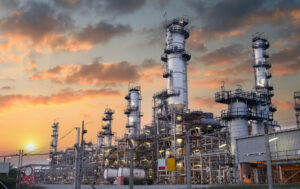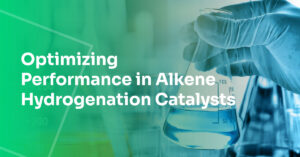Heterogeneous catalysis is a cornerstone in modern industrial practices, driving countless chemical reactions essential to manufacturing everything from pharmaceuticals to petrochemicals.
This process, where the catalyst is in a different phase than the reactants, offers distinct advantages in terms of ease of separation and recyclability. However, implementing heterogeneous catalysis on an industrial scale presents a unique set of challenges that can impact efficiency, cost, and sustainability.
Join us as we uncover how Applied Catalysts help overcome these obstacles, paving the way for more efficient and sustainable industrial practices.
The Significance of Heterogeneous Catalysis in Industrial Processes

Heterogeneous catalysis is a fundamental process in chemical reactions, particularly prevalent in industrial settings due to its distinct operational benefits.
Unlike homogeneous catalysis, where the catalyst operates in the same phase as the reactants (typically in a liquid solution), heterogeneous catalysts are in a different phase—usually solid, while the reactants are in a liquid or gaseous state.
This separation of phases is crucial for numerous reasons, particularly when it comes to the recovery and reuse of the catalyst.
Heterogeneous vs. Homogeneous Catalysis
Understanding the difference between these two types of catalysis is key to selecting the right catalyst for a specific process.
Phase of Operation
- Heterogeneous: Catalyst in a different phase than the reactants, usually solid.
- Homogeneous: Catalyst and reactants in the same phase, typically liquid.
Separation & Recovery
- Heterogeneous: Easier separation due to phase difference. Catalysts can often be reused.
- Homogeneous: Separation can be challenging and costly; often requires additional steps such as distillation.
Reaction Conditions & Control
- Heterogeneous: Offers robust operation in harsh conditions but can be limited by mass transfer issues.
- Homogeneous: Allows for greater control over reaction conditions and can offer higher selectivity; however, it may require precise temperature and solvent conditions.
Application Suitability
- Heterogeneous: Preferred in large-scale continuous processes like petroleum refining and pollution control.
- Homogeneous: Often favored in fine chemical and pharmaceutical synthesis where high selectivity and specificity are required.
Basic Principles and Mechanics
Heterogeneous catalysis occurs at the interface between the phases. The reactants diffuse to the catalytic surface, where the chemical reaction occurs. The products then desorb from the surface and diffuse away. This process involves several steps:
- Adsorption: Reactants adsorb onto the catalyst’s surface.
- Reaction: Adsorbed substances react with each other on the catalyst surface.
- Desorption: Reaction products desorb from the surface and are released into the bulk phase.
The effectiveness of a heterogeneous catalyst is often determined by the surface area available for reaction. Greater surface areas provide more active sites for the reactants to interact, thus enhancing the catalyst’s effectiveness.
| Examples of Heterogeneous Catalysis in Industrial Chemical Processes | |
| Oil Refining | Heterogeneous catalysts are used extensively in refining processes, such as hydrocracking and fluid catalytic cracking, to break down complex hydrocarbons into simpler molecules like gasoline and diesel. |
| Chemical Synthesis | Iron catalysts facilitate the reaction under high temperatures and pressures in the production of ammonia via the Haber process. |
| Environmental Applications | Automobile catalytic converters use heterogeneous catalysts (such as platinum, palladium, and rhodium) to convert harmful emissions from engines into less toxic substances. |
Key Challenges of Heterogeneous Catalysis in Industrial Practices

While applications of heterogeneous catalysis plays a crucial role in various industrial processes, it is not without its challenges. These challenges can impact the efficiency, cost-effectiveness, and scalability of processes, making it essential for companies like Applied Catalysts to develop innovative solutions to overcome them.
Deactivation and Poisoning
One of the most significant challenges in heterogeneous catalysis is the deactivation of the catalyst over time.
This can occur due to:
- Chemical Impurities: Impurities in the reactants can accumulate on the catalyst’s surface, blocking active sites and reducing its effectiveness.
- Reaction By-products: Certain heterogeneous catalytic reactions can produce by-products that coat the catalyst, similarly inhibiting its activity.
These factors lead to a gradual loss of catalyst performance, necessitating frequent regeneration or replacement, which can be costly and time-consuming.
Mass Transfer Limitations
The efficiency of a heterogeneous catalyst is heavily dependent on the ability of reactants to reach and interact with active sites on the catalyst surface. Challenges include:
- Diffusion Barriers: Poor diffusion of reactants to the catalyst surface can limit reaction rates, particularly in catalysts with low porosity or improper pore size distribution.
- Product Removal: Inefficient removal of products from the catalyst surface can also hinder the overall reaction rate, as it prevents fresh reactants from accessing active sites.
Optimizing the physical structure of the catalyst to enhance mass transfer is crucial for maximizing its performance.
Thermal Stability
Heterogeneous catalysts are often used under harsh conditions, including high temperatures. However, not all catalysts can withstand such environments:
- Structural Degradation: High temperatures can cause structural changes in the catalyst, such as sintering, where particles coalesce and reduce the surface area available for reaction.
- Activity Loss: Thermal instability can lead to a decrease in catalytic activity, compromising the process efficiency and leading to potential process failures.
Developing catalysts with enhanced thermal stability is essential for applications involving high temperatures.
Scalability
Translating catalytic processes from the laboratory to industrial scale presents several challenges:
- Replicating Conditions: Conditions optimized in small-scale experiments often do not translate directly to larger systems due to differences in mixing, heat transfer, and mass transfer.
- Cost and Material Availability: Scaling up often requires significantly more catalyst material, which can be expensive and logistically challenging if rare or costly materials are involved.
Ensuring that catalysts are designed with scalability in mind from the outset is crucial for their successful industrial application.
Advances in Heterogeneous Single-Cluster Catalysis

Heterogeneous single-cluster catalysis represents a significant frontier in the field of catalysis, offering innovative solutions to some of the longstanding challenges in industrial chemical reactions.
This advanced approach focuses on the use of single atomic cluster catalysts, which provide unparalleled activity and selectivity due to their unique properties.
Technological Advances
Increased Surface Reactivity
Single-cluster catalysts consist of isolated atomic clusters fixed onto a support, maximizing the exposure of active sites. This structure dramatically increases surface reactivity, allowing for more efficient catalytic processes.
Precise Molecular Control
These catalysts offer precise control at the molecular level, enabling selective reactions that are often unachievable with bulk catalysts. This precision stems from the ability to tailor the electronic and structural properties of the clusters during synthesis.
Development of Durable Clusters
Recent advancements have focused on enhancing the durability of these clusters, ensuring they remain stable under various industrial conditions without losing their catalytic properties.
Impact on Overcoming Traditional Challenges
- Deactivation and Poisoning: The unique design of single-cluster catalysts minimizes the risks of deactivation and poisoning. The enhanced selectivity reduces the formation of by-products that could foul the catalyst, while the stability of the clusters prevents degradation from impurities.
- Mass Transfer Limitations: The small size and high dispersion of single-cluster catalysts improve mass transfer efficiencies. Reactants can access the active sites more readily, and products can be removed quickly, optimizing the overall reaction rate.
- Thermal Stability: Single-cluster catalysts are designed to be thermally stable, maintaining their structure and functionality even under high temperatures. This stability is crucial for processes that require elevated temperatures, addressing one of the major challenges in heterogeneous catalysis.
- Scalability Issues: The efficiency and robustness of single-cluster catalysts facilitate scaling from laboratory settings to full-scale production. Their predictable behavior and high activity reduce the need for extensive re-optimization of conditions, making scale-up more straightforward and less costly.
Leverage the Advantages of Heterogeneous Catalysis with Applied Catalysts

With Applied Catalysts, industries can achieve enhanced efficiency and sustainability but also significant economic benefits. Our tailored solutions and comprehensive support system ensure that every client can optimize their catalytic processes to meet contemporary challenges head-on, driving innovation and success in their respective fields.
How Applied Catalysts Can Enhnace Processes
At Applied Catalysts, we understand the challenges associated with heterogeneous catalysis and have developed strategies to optimize and overcome them.
Innovative Catalyst Design
We engineer catalysts to enhance their stability, activity, and selectivity. By focusing on the molecular and atomic scale, we ensure that our catalysts perform optimally under a variety of conditions.
Tailored Solutions
Recognizing that each industry has unique needs, we offer custom catalyst solutions. These are designed to integrate seamlessly with existing client processes, enhancing scalability and operational efficiency.
Comprehensive Support and Services
Our commitment extends beyond catalyst delivery. We provide ongoing support and engage in continual research and development to keep our clients at the forefront of catalysis technology. This includes troubleshooting, process optimization, and periodic reviews to ensure that the catalysts deliver peak performance throughout their lifecycle.
Ready to Enhance Your Catalytic Processes?

Facing challenges with catalyst deactivation, struggling with scalability, or seeking more sustainable and efficient catalytic solutions?
Don’t let catalytic challenges slow you down. Reach out today and let Applied Catalysts help you optimize every reaction. Schedule a discovery session and we’ll explore your specific needs and discuss how our innovative catalyst designs, custom solutions, and comprehensive support can drive your success.
Recent Posts
Using Industrial VOC Oxidation Catalysts for Air Pollution Control
In today’s industrial landscape, managing environmental impact is not just a regulatory compliance issue but a critical element of sustainable operational practices. Among the various pollutants, Volatile Organic Compounds (VOCs)…
Read MoreHow to Prevent Catalyst Poisoning at the Industrial Scale
Catalyst poisoning remains one of the most significant challenges in industrial catalysis, potentially crippling the efficiency of processes that are vital to manufacturing sectors worldwide. This phenomenon occurs when chemical…
Read MoreOptimizing Performance in Alkene Hydrogenation Catalysts
The hydrogenation of alkenes is a pivotal process that transforms unsaturated hydrocarbons into saturated ones. This process has vast applications in pharmaceuticals and petrochemicals. Central to this transformative process is…
Read More


